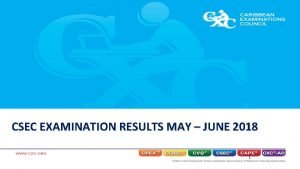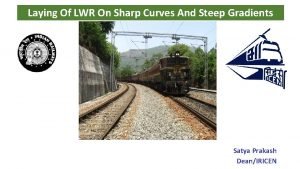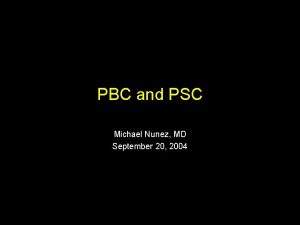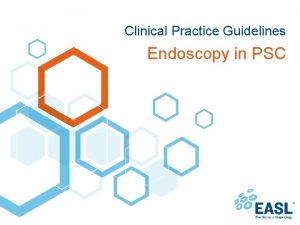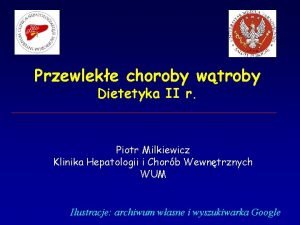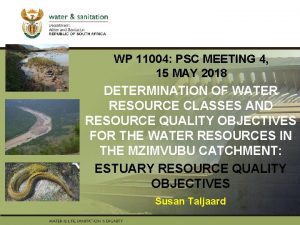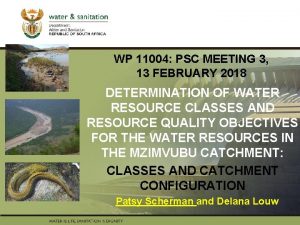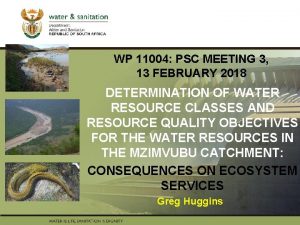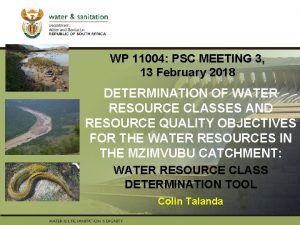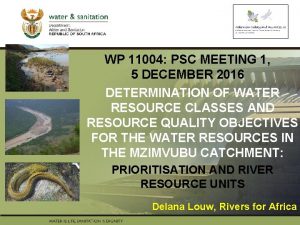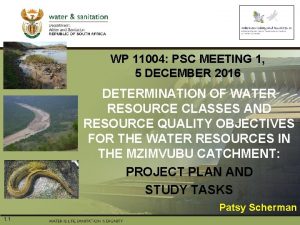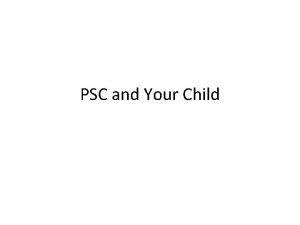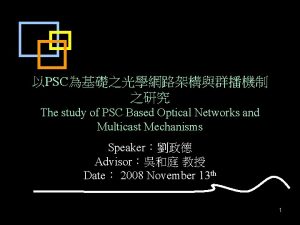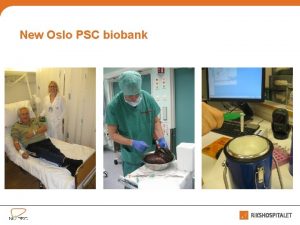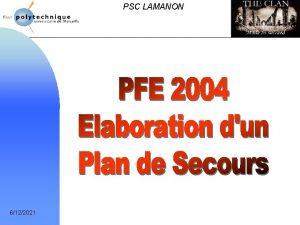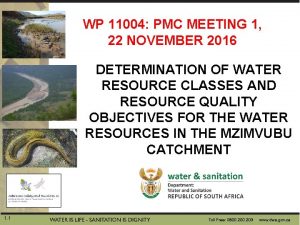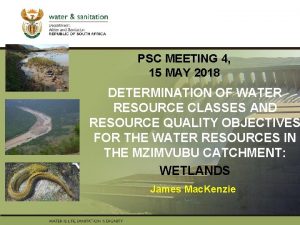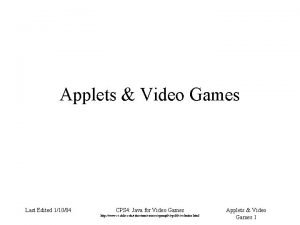WP 11004 PSC MEETING 4 15 MAY 2018

















- Slides: 17

WP 11004: PSC MEETING 4, 15 MAY 2018 PRESENTATION TITLE DETERMINATION OF WATER Presented by: Name Surname RESOURCE CLASSES AND Directorate RESOURCE QUALITY OBJECTIVES Date FOR THE WATER RESOURCES IN THE MZIMVUBU CATCHMENT: GROUNDWATER RQOs Karim Sami

GROUNDWATER RQOs

GW CONTRIBUTION TO THE RESERVE GW component of the Reserve for each GRU is calculated by: Reserve = (EWRgw + BHNgw), where: • BHNgw = basic human needs derived from groundwater • EWRgw = groundwater contribution to EWR Groundwater contributions for the EWR include: • Baseflow to rivers and springs, including high lying springs fed by interflow. • Seepage to wetlands and groundwater dependent ecosystems. The allocable groundwater is the difference between recharge and the groundwater component of the Reserve; and should not exceed 65% to ensure sustainability.

HOW DOES WATER USE AFFECT GW? • Abstraction: Reduction of groundwater baseflow by interception of GW or by drawdown and gradient reversal near rivers. • Alien Invasive Plants (AIPs): increased evaporation of shallow groundwater or reduce interflow from high lying areas.

AIMS 1) Maintain the required groundwater contribution to the EWR 2) Protect groundwater resources for the direct and indirect users • RQOs may stipulate: – the volume of abstraction that would cause an – – undesirable reduction in baseflow or undue stress on aquifer specific distances from a river flow at gauging stations and maximum baseflow reduction GW levels water quality conditions (linked to potable use)

CRITERIA USED FOR SETTING RQOs • Abstraction: Harvest Potential, Allocable Groundwater • Baseflow: Distance of abstraction from river, low flows at gauging stations • Water level: trends • Water quality: monitoring where poor quality is an issue Water Quality Classes (Potability): Class I: 95% of samples of water quality class 0 and 1 Class II: 75% of samples of water quality class 0 -2 Class III: <75% of samples class 0 -2

GROUNDWATER CLASSIFICATION BY STRESS AND RESOURCE QUALITY GW present status Description Unmodified, pristine conditions A B Stock watering, farm domestic water supply, rural water supply (use ranges between 5% and 20% of recharge) Moderate volumes of GW usage, little or no negative impacts apparent Small-scale irrigation, rural water supply, water supply for villages and small towns (use ranges between 20% and 40% of recharge) High volumes of GW usage, but with little apparent negative impact D E F Very limited use (GW use is less than 5% of recharge) Low volume GW usage, largely natural conditions, no negative impacts apparent C Note: usage of 65% (D) = lowest limit of sustainability for GW use + protection. Guide Water supply for large rural communities, medium to large towns, large-scale irrigation (use ranges between 40% and 65% of recharge) Stressed system due to overabstraction of GW or inappropriate landuse High volume of major groundwater users (use range between 65% and 95% of recharge) Critical over-abstraction of GW or highly sensitive hydrological environment Very high volume of major groundwater users (GW use is in excess of 95% of recharge) Stress index ≤ 0. 05 – 0. 2 – 0. 4 – 0. 65 – 0. 95 > 0. 95 Note that the GW present status categories are NOT directly linked to Ecological Categories used for rivers and estuaries.

STRESS INDEX

GROUNDWATER USE IN T 3 WARMS = 12. 72 Mm 3/a Aquifer Recharge = 491. 711 Mm 3/a) The fraction of boreholes that are potable (potability index) exceeds 85%, except in T 35 K + T 33 H.

EXAMPLE OF RQOs - ABSTRACTION Quat T 31 F Groundwater numerical RQO Groundwater narrative RQO Abstraction Baseflow Water Level Water Quality All users to comply with existing allocation schedules, including the GA and Schedule 1, and individual licence conditions within the Harvest Potential Due to groundwater contribution to baseflow, abstraction within 100 m of perennial rivers should be restricted to use less than the GA. Water level monitoring required near Cedarville and areas of high abstraction. No downward trend of static water level should be seen over a period of 5 years No water quality monitoring required The Allocable groundwater is 5. 487 Mm 3/a Allocable = 65% of Aquifer recharge Reserve

BASEFLOW REDUCTION

EXAMPLE OF RQOs- BASEFLOW Quat T 35 C, T 35 F Groundwater numerical RQO Groundwater narrative RQO Abstraction Baseflow Water Level Water Quality All users to comply with existing allocation schedules and individual licence conditions within the Harvest Potential Due to baseflow depletion, further SFR activities should be avoided, especially, within 100 m of perennial stream. Due to the low groundwater use and low aquifer contribution to baseflow, monitoring not required Some boreholes may have elevated natural nitrate and fluoride levels, so nitrate and fluoride need to be tested for domestic boreholes. Insufficient data exists, and data collection is required Low flows at T 3 H 009 should not be less than an average of 8. 92 Mm 3/a for T 35 C. T 35 F is ungauged and cannot be monitored by flow measurements


CONCLUSIONS (1) • Groundwater in all catchments under-utilised. • Total use = 22 MCM/a, harvest potential = 317 MCM/a, aquifer recharge = 492 MCM/a. • Allocable Groundwater = 263 Mm 3/a. • Of the 51 quaternary catchments, 42 have a GW Present Status of A (stress index < 0. 05), 7 as B (stress index < 0. 2), and only 2 are classified as C (stress index < 0. 4). • Cumulative baseflow = 2 899 MCM/a; of which 87% is derived as interflow from springs above the regional groundwater level. • Groundwater low flow EWR is 573. 56 MCM/a. • Groundwater-supported BHNR is 6. 2 MCM/a. • Groundwater component of the Reserve = 580 MCM/a, which is only 2. 9% of recharge.

CONCLUSIONS (2) • 241 MCM/a of groundwater can still be allocated. • Groundwater quality is good: 85% of samples Class 0, 8% Class 1, 2% Class 2, and 5% Class 3 and 4 samples. PRIORITY MONITORING AREAS FOR WATER LEVEL AND ABSTRACTION • Catchment Stress Index Priority T 31 F 0. 341 Moderate T 33 A 0. 371 Moderate PRIORITY MONITORING AREAS FOR BASEFLOW REDUCTION • Catchment Baseflow Reduction Priority T 35 F 43. 85 Moderate T 35 C 30. 43 Moderate •

CONCLUSIONS (3) PRIORITY MONITORING AREAS FOR WATER QUALITY • Over large parts of the study area insufficient data exist to characterise groundwater quality. The T 33 T 36 tertiary catchments lack sufficient data. • Catchments T 35 K and T 33 H have a high proportion of boreholes with elevated salinities; cause unknown.

QUESTIONS FOR CLARIFICATION
 Que letra continua m v t m j
Que letra continua m v t m j Aua meeting 2018
Aua meeting 2018 Nrg oncology semi annual meeting 2018
Nrg oncology semi annual meeting 2018 Nrg oncology meeting
Nrg oncology meeting Today meeting or today's meeting
Today meeting or today's meeting Proposal kickoff meeting agenda
Proposal kickoff meeting agenda What is meeting and types of meeting
What is meeting and types of meeting Types of meeting
Types of meeting Cxc 2018 results
Cxc 2018 results Einsteinufer
Einsteinufer Salient features
Salient features Psc sleeper dimensions
Psc sleeper dimensions Primary sclerosing cholangitis
Primary sclerosing cholangitis Psc group llc
Psc group llc Psc tracker web app
Psc tracker web app Michael nunez md
Michael nunez md Easl guidelines psc
Easl guidelines psc Psc
Psc








